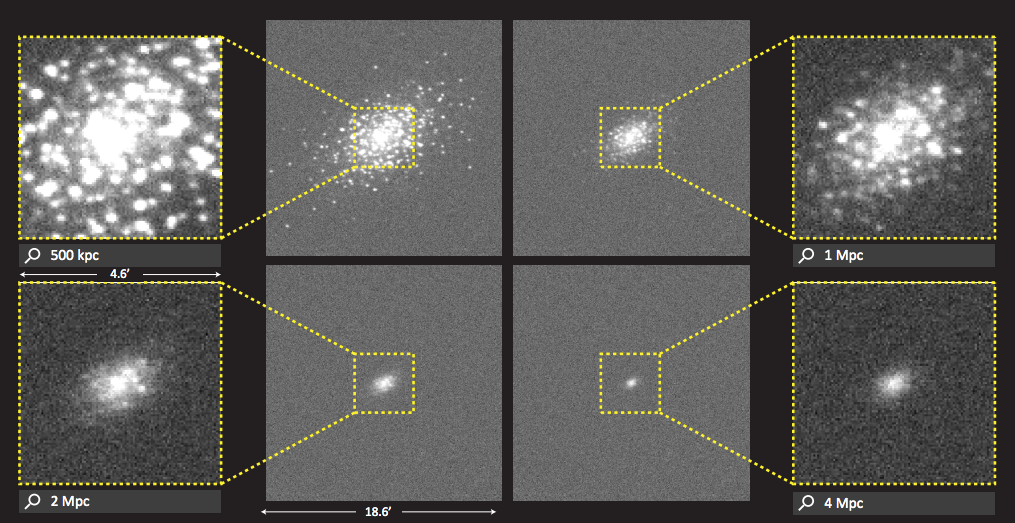Editor’s note: Astrobites is a graduate-student-run organization that digests astrophysical literature for undergraduate students. As part of the partnership between the AAS and astrobites, we occasionally repost astrobites content here at AAS Nova. We hope you enjoy this post from astrobites; the original can be viewed at astrobites.org!
Title: Hunting Faint Dwarf Galaxies in the Field Using Integrated Light Surveys
Authors: S. Danieli, P. van Dokkum, C. Conroy
First Author’s Institution: Yale University
Status: Submitted to ApJ
One marvelous fact about our universe is that at the largest scales, it is fractal. Unlike true fractals, which exhibit exact self-similarity, the universe is only statistically self-similar. If you looked at the most massive objects in the universe, a record held by the gargantuan, invisible dark matter blobs holding clusters of galaxies together, which clock in with masses upwards of 1015 times the mass of the Sun, you’d find that they’re rife with smaller blobs, or “halos” of dark matter. Many of these smaller dark matter halos are inhabited by a galaxy, including giant bright elliptical galaxies, the smaller and fainter spiral galaxies, and hordes of yet smaller, fainter galaxies. Peering closer at, say, one of the dark matter halos of a Milky Way-like spiral galaxy, which clocks in at about 1012 times the mass of the Sun, you’d find that it in turn is surrounded by a similar but down-sized army of even smaller dark matter halos, which may contain even fainter “dwarf” galaxies. And the halos of each of these dwarf galaxies in turn can host their own army of even tinier dark matter halos. If you just looked at the dark matter of a galaxy cluster, a single spiral galaxy, or a dwarf galaxy, it would be hard to tell which was which — they would roughly look like scaled up (or down) versions of each other.
How far down does this fractal structure go? We can search part of the way down by searching for the smallest, faintest galaxies that live within them — which is an incredibly difficult task. To go further down to the smallest dark matter halos, which may be completely dark, and thus unobservable by usual means (i.e. by light), we’ll have to turn to more exotic methods. The faintest dwarf galaxies we’ve found thus far have been discovered by hunting for clusters, or “overdensities,” of stars. This technique can only uncover dwarfs in which we can observe individual stars, which we can distinguish only out to a pitiful distance — just to up to about 5 Mpc away, which is a little beyond the edge of the Local Group of neighborly galaxies.
What about the faint dwarfs that live even further away, far enough that they appear as fuzzy patches of light, and not as collections of stars? The authors of today’s paper discuss our prospects for finding these “integrated light” images of dwarfs (see Fig. 1) as far away as 10 Mpc. To do this, they set out to ask a simple question: how many galaxies could they find, given a telescope with a particular resolution and sensitivity?

Figure 1. Simulated observations of a faint dwarf galaxy at different distances from the Milky Way. If the dwarf is just outside the Milky Way, at about 500 kpc, we can see the individual stars within the galaxy. However, if such a galaxy is farther away, it becomes increasingly difficult to resolve individual stars. At 4 Mpc, it only appears as a fuzzy blob of light, and we can no longer see the individual stars in the galaxy. Detecting such faraway, faint dwarfs requires new search methods. [Danieli et al. 2017]

Figure 2. The number of dwarfs between 3–10 Mpc that we could see with a telescope of a given resolution and sensitivity. The angular resolution is shown on the horizontal axis, and the sensitivity, here quantified as the surface brightness μ, is shown on the vertical axis. The colors and black contour lines denote the number of dwarfs you can see per square degree in the sky (an area equivalent to five times the Moon’s). The two panels show results from two different SMHM relations (see above paragraph for details). Brighter dwarf galaxies — those with smaller μ and thus at the bottom of the plots — can be seen no matter the resolution of your telescope. Fainter dwarfs — those with larger μ and higher up on the plot — are found in greater abundance, and we need good spatial resolution (fewer arcsecs) to detect them all. [Danieli et al. 2017]
The authors calculate that using this “integrated light” method to hunt for faint dwarfs using the Dragonfly Telescope Array, a telescope that was designed for the task, we could find a similar number of galaxies — if not more — as with surveys that rely on the traditional method of finding clusters of individually resolved stars. This is an exciting result. The few smallest, faintest galaxies we’ve found so far currently puzzle astronomers: how many of them are there? Why are they so faint? How did their stars form? We could begin to unravel these mysteries once we find more of these tiny galaxies.
About the author, Stacy Kim:
I am a fourth-year graduate student in The Ohio State University’s Department of Astronomy. On a day-to-day basis, you can typically find me attempting to smash clusters of galaxies together inside big supercomputers with Dr. Annika Peter to see if cluster mergers are good testbeds for dark matter collisionality. As an undergraduate at Caltech, I spent a few years chasing photons where planets are thought to form (or, as they say, performing Monte Carlo radiative transfer calculations of protoplanetary disks) with Dr. Neal Turner of the Jet Propulsion Laboratory. When I’m not sitting in front of a computer trying to translate cosmic thoughts into pithy lines of code, you can find me in the kitchen or on the walls of a climbing gym.
